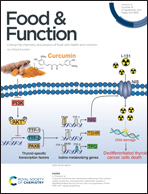IgE epitope analysis of sarcoplasmic-calcium-binding protein, a heat-resistant allergen in Crassostrea angulata†
Abstract
Sarcoplasmic-calcium-binding protein (SCP) has been investigated as a novel allergen in Crassostrea angulata. Nevertheless, knowledge of its effector-cell-based allergic relevance and epitopes is limited. In this study, the heat-resistant allergen SCP was able to induce significant upregulation of CD63 and CD203c (p < 0.05), which showed obvious allergenicity in a basophil activation test. Furthermore, immunoinformatic tools, a one-bead-one-compound peptide library, and phage display technology were combined to analyze the allergenic epitopes of SCP. Five linear epitopes named L-SCP-1 (AA22–33), L-SCP-2 (AA64–75), L-SCP-3 (AA80–90), L-SCP-4 (AA107–116), and L-SCP-5 (AA144–159) were verified using serological tests. Additionally, two conformational epitopes (C-SCP-1 and C-SCP-2) were determined, and C-SCP-1 was located at one of the calcium-binding sites (AA106–117). Moreover, SCP showed weaker typical α-helical features and higher hydrophobicity after Ca2+ depletion, which reduced its IgE-binding capacity. Overall, these epitope data could enhance our understanding of oyster allergens, which could be used to develop hypoallergenic shellfish products.



 Please wait while we load your content...
Please wait while we load your content...